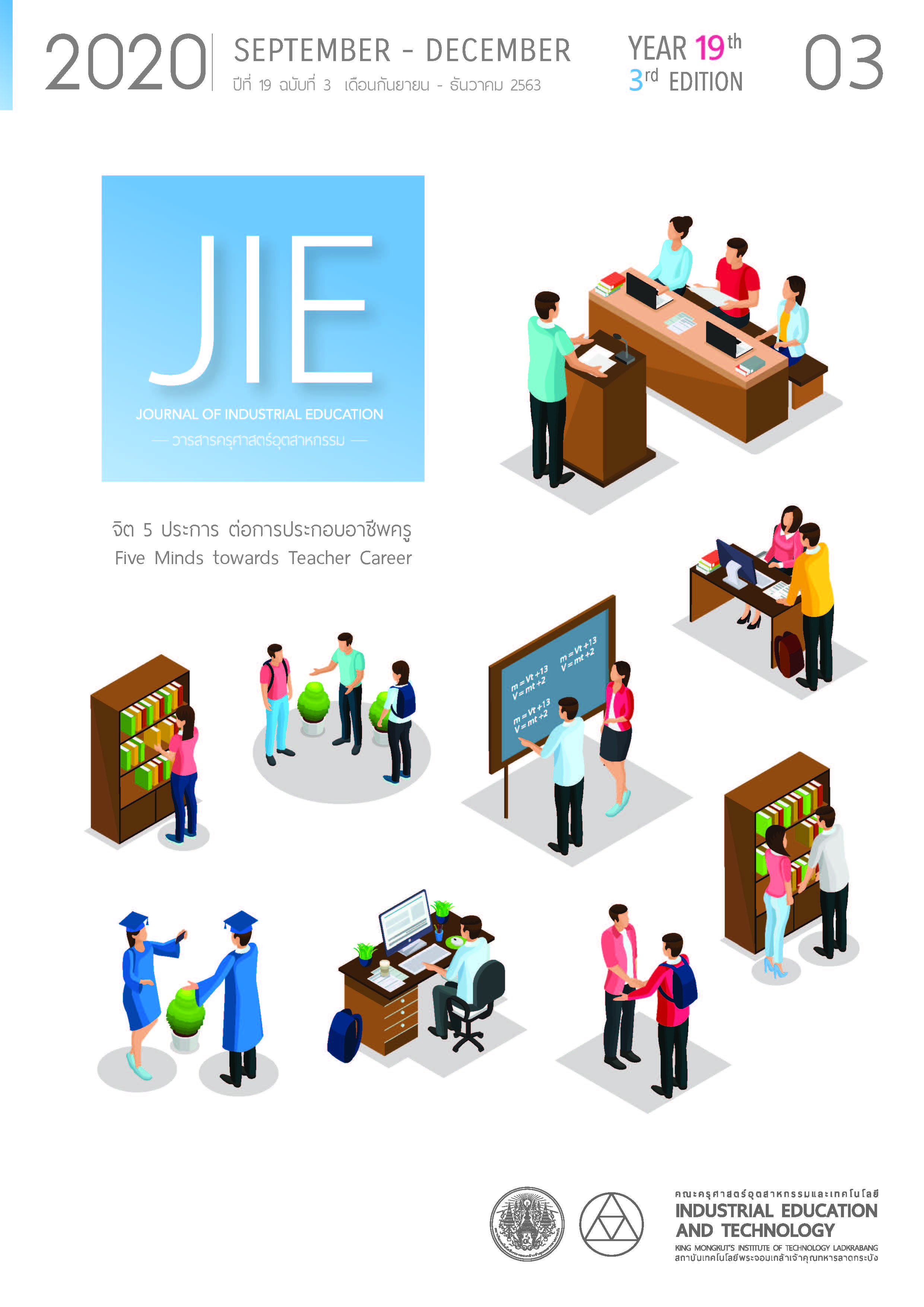การพัฒนาแบบวัดภูมิคุ้มกันทางใจสำหรับนักศึกษาระดับปริญญาตรี
Main Article Content
บทคัดย่อ
การวิจัยครั้งนี้มีวัตถุประสงค์เพื่อพัฒนาแบบวัดภูมิคุ้มกันทางใจสำหรับนักศึกษาระดับปริญญาตรี โดยในขั้นแรกของการพัฒนาแบบวัดภูมิคุ้มกันทางใจ ผู้วิจัยได้ใช้วิธีวิจัยเชิงคุณภาพเพื่อกำหนดความหมายของภูมิคุ้มกันทางใจด้วยการทบทวนเอกสารที่เกี่ยวข้อง การสัมภาษณ์เชิงลึกด้วยแนวคำถามกึ่งโครงสร้างกับผู้ให้ข้อมูลกลุ่มอาจารย์ที่สอนในรายวิชาชีพครู จำนวน 15 คน และใช้แบบสอบถามปลายเปิดกับนักศึกษาวิชาชีพครู ระดับปริญญาตรี จำนวน 80 คน ได้นิยามความหมายของภูมิคุ้มกันทางใจ ส่วนในขั้นที่ 2 ผู้วิจัยได้นำแบบวัดภูมิคุ้มกันทางใจที่ผู้วิจัยพัฒนาขึ้น มาวิเคราะห์ได้ค่าดัชนีความตรงเชิงเนื้อหา เท่ากับ 0.80-1.00 ค่าอำนาจจำแนก เท่ากับ 0.328 - 0.688 และความเชื่อมั่นทั้งฉบับได้ค่าสัมประสิทธิ์สหสัมพันธ์แบบครอนบาค (Cronbach’ s Alpha coefficient) เท่ากับ 0.913 ขั้นที่ 3 ผู้วิจัยเก็บข้อมูลกับกลุ่มตัวอย่างที่เป็นนักศึกษาวิชาชีพครู จำนวน 500 คน เพื่อทำการวิเคราะห์องค์ประกอบเชิงสํารวจ ด้วยวิธีการสกัดองค์ประกอบหลัก (Principal component analysis) และหมุนแกนองค์ประกอบตั้งฉากด้วยวิธีแวริแมกซ์ (Varimax) ผลการวิจัย พบว่า องค์ประกอบของแบบวัดภูมิคุ้มกันทางใจ แบ่งออกเป็น 4 องค์ประกอบ ได้แก่ ความสามารถในการปรับตัว การเข้าใจผู้อื่น การเข้าใจตนเอง และการรู้คุณค่าตนเอง ซึ่งสามารถอธิบายความแปรปรวนของภูมิคุ้มกันทางใจ ได้ร้อยละ 52.905 องค์ประกอบที่ 1, 2, 3 และ 4 สามารถอธิบายความแปรปรวนของภูมิคุ้มกันทางใจ ร้อยละ 36.336, 6.207, 5.722, 4.640 ตามลำดับ
Article Details
"ข้อคิดเห็น เนื้อหา รวมทั้งการใช้ภาษาในบทความถือเป็นความรับผิดชอบของผู้เขียน"
References
Piyamanotham, W. (2002). Talk to a psychologist 1. Bangkok: se-education. 17-25. (in Thai).
Kantathanawat, T. (2020). Educational psychology for learner development. Bangkok: Mean Service supply. 177-182. (in Thai)
SiriratReka, T. (2017). RQ - Resilience Quotient.[online]. Available: https://www.happyhomeclinic.com/a21-RQ.htm Retrieved June 25, 2020. (in Thai)
American Psychological Association. (2007). What is resilience? .[online]. Available: http://psychcentral.com/lib/2007/what-is-resilience/ Retrieved May 9, 2020.
Grotberg, E. (1995). A Guide to Promoting Resilience in Children: Strengthening the Human Spirit. Early Childhood Development: Practice and Reflections, v. 8. The Hague-NO: Bernard Van Leer Foundation. 6-8.
American Psychological Association. (2018). The Road to Resilience. Report of the practice directorate on resilience. .[online]. Available: https://www.apa.org/helpcenter/road-resilience Retrieved May 9, 2020.
Ong, A. D., Bergeman, C. S., Wallace, K. A., & Bisconti, T. L. (2006). “Psychological resilience, positive emotions, and successful adaptation to stress in later life.” Journal of Personality and Social Psychology. 91,4: 730-749.
Oraphin Choochom, Supaporn Tanachanan & Tasana Thongpukdee. (2011). Antecedents and Consequences of Youths’ Psychological Immunity. (Research No. 137). Bangkok: Behavioral Science Research Institute, Srinakharinwirot University. 18. (in Thai)
Wanichbancha, K. (2003). Advanced Statistical Analysis with SPSS for Window .3rd ed. Bangkok: Nature. 49-53 (in Thai)
Elo, S., & Kyngas, H. (2008). “The qualitative content analysis process.” Journal of advanced nursing. 62: 107-115.
Comrey, A. L., & Lee, H. B. (1992). A first course in factor analysis. 2nd ed. Hillsdale, New Jersey: Erlbaum. 42-46
Hair J.F., Black, W.C., Babin, B.J., Anderson, R.E., & Tatham, R.L. (2010). Multivariate data analysis. 7th ed. Upper Saddle River, New Jersey: Prenitce-Hall. 447-455.
Wiratchai, N. (2006). Lisrel Model: Statistical Analysis for Research. 3rd ed. Bangkok: Chulalongkorn University. 115-117. (in Thai)
Bollen, K.A. (1989). Structural Equations with Latent Variables. North Carolina: John Wiley & Sons.
Drost, E. (2011). “Validity and Reliability in Social Science Research.” Education Research and Perspectives. 38, 1: 105-123.
Kachonsil, B. (2002). Statistics Research. Bangkok: PN Publishing. 37-38. (in Thai)
Gable, R.K. (1986). Instrument Development in the Affective Domain. Boston, MA: Kluwer-Nijhoff. 249.
Lazarus, R. S. & Folkman, S. (1984). Stress appraisal and coping. New York: Springer Publishing Company. 47-53.
Aurel, I. C. (2013). “Adaptation and Stress for the First Year University Students.” Procedia - Social and Behavioral Sciences. 78: 718-722.
Suwitthayarat, K. (2014). “The Study and Development of Social Intelligence for Higher Education Students in the South of Thailand.” Suthiparithat Journal. 28, 86, April- June: 126-151. (in Thai)
Gelso, C. J., & Fretz, B. R. (2001). Counseling psychology (2nd ed.). Fort Worth, TX: Harcourt Brace Jovanovich College Publishers. 195-196.
Marcic, R., & Kobal, G. D. (2011). “Gender differences in self-concept and self-esteem components.” Studia Psychologica, 53, 4: 373-384.
Weiten, W., Dunn, D. S., & Hammer, E. Y. (2012). Psychology applied to modern life: adjustments in the 21st century. Belmont, CA: Wadsworth. 46-48.
Maslow, A. M. (1970). Motivation and Personality. 2nd ed. New York: Harcourt, Brace&world. 62-65.
Coopersmith, s. (1981). The Antecedent of Self-esteem. California: Consulting Psychologists Press. 42-43.

